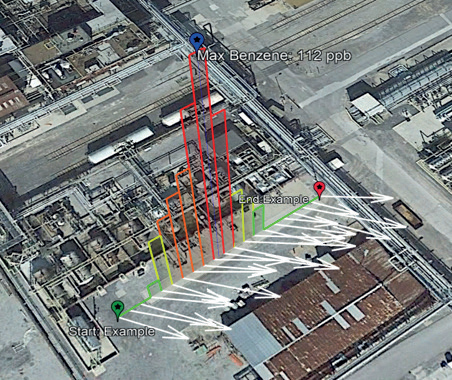One of the most urgent matters in the energy industry worldwide is pollution, and specifically the release of dangerous chemicals and gasses into the air and surrounding environments.
Fugitive Emissions Journal had the pleasure of speaking with John Nowak, Client Relationship Manager at TRICORD Consulting. Nowak leads a team of primarily chemical engineers that has been making huge strides in technology research and development, focusing on Geospatial Measurement of Air Pollutants (GMAP) technology, and applying that technology to finding fugitive emissions. Nowak described in detail how GMAP technology can be used to mitigate compliance risks, while also providing companies with more accountability, while building trust within surrounding communities
By Sara Mathov
Background
Nowak’s career began in consulting, after first graduating from university, with two degrees, one in chemical engineering and one in chemistry. Nowak spent a number of years doing air quality consulting before finding himself working with technology implementing large scale automated systems to calculate emissions for industry sources, including fugitives. He then spent a few years within the oil & gas industry, at LINN Energy helping oversee their permitting and compliance in multiple states, before finding his current home at TRICORD. While at LINN Energy he saw firsthand how technology and environmental regulation were converging around fugitive detection as LINN was one of the first companies to use FLIR cameras in the field to supplement other Leak Detection and Repair (LDAR) technologies approved by the EPA.
FLIR cameras provided a method to rapidly identify emission sources qualitatively and opened up the energy industry for other technologies like GMAP, which is now Nowak’s focus. “I have shifted more to the sales side now, so I help people learn about new technologies and how it can benefit the company.” Nowak said. “I sort of fell into fugitive emissions, and then over time, developed a passion for it. By understanding fugitive emissions, I have learned how a facility operates, and the different challenges within them.”
Nowak explained that although industry is unlikely to completely abolish fugitive emissions, our understanding of them and their potential sources can be improved, as well as what causes them, how to reduce them, and how to capture them. This type of investigation will allow individual players within the energy industry to locate high emitters that they may not have known about in the past, thus allowing them to mitigate risk, and come up with solutions in order to improve air quality.

GMAP: Real-Time Mobile Air Monitoring
The two main technologies that make up the GMAP unit are the UV spectrometer paired with real time site collected meteorological data from a mobile weather station. Together, they can monitor up to 14 different pollutants while identifying the direction of the emission source post being processes through proprietary software and imaged on a map. Air quality consultants are most concerned with benzene during these investigations, as benzene is a highly regulated, prevalent, and a problematic pollutant. Many monitoring systems collect data on a group of chemicals collectively known as BTEX, comprising benzene, toluene, ethylbenzene and xylene. “BTEX is known as a pollutant of concern for the industry,” Nowak explained. “Our clients, especially anybody who has a benzene fenceline monitoring program, will be focused on those pollutants – the most detectable ones.”
Sometimes, GMAP technology is so sensitive that it picks up on pollutants in the surrounding areas. For example, Nowak described a scenario in which their GMAP system detected tar around a business that was having a new roof installed. GMAP also often picks up on chemicals being released at nearby gas stations. It is evident that the technology is very thorough.
This sensitivity is what makes the technology so important; the more sensitive, the better the opportunity more pollutants will be identified from a further distance. Nowak stated, “We can drive by and see something that is causing emissions, come back five minutes later, and it is gone. Then, we come back around, maybe an hour later, and it is there again. That gives us very valuable information; we can take that back to operations and say, ‘hey, we are seeing this happening’. Then we ask, does that correlate with any maintenance activities? It is that sensitive and accurate.”
Benefits and Challenges
GMAP technology is clearly useful, but what are its drawbacks? According to Nowak, the biggest challenge is collecting enough data with the GMAP unit to make educated assessments.
This cannot occur on just one pass or drive through of an area; rather, the GMAP unit needs to make multiple passes of an area to properly identify emission sources. Intermittent sources can only be identified if the GMAP is in the area when emission occur and to identify emission sources multiple upstream passes may be needed, which can be time consuming. Once emissions are detected, the goal is to identify the emission source. One method to isolate an emission source area is to continue making pass upwind of the source, until emissions cannot be detected. Even then, this system is not foolproof, since changes in wind direction may make moving upstream of the source difficult.
Overall, the benefits of this technology seem to outweigh its challenges. In order to be more efficient, GMAP units can screen an area by traveling at approximately ten miles an hour in order to cover a good amount of distance per day while maintaining the ability to identify sources. The technology can look at very low concentrations from the emission sources, measuring in the parts per billion range, with benzene being detectable down to two parts per billion. Nowak asserted that overall, this is really beneficial technology.
Going forward, researchers are looking at different technologies to potentially supplement the UV technology to include additional pollutants such as ethylene oxide, carbon dioxide, and methane. Recently, the oil & gas industry is facing methane challenges from leaks, therefore, further developing and innovating existing technology would be very applicable to this sector.
Generally speaking, companies within the oil & gas and refining industries want to build good relationships within surrounding communities, so they are very amenable to the type of data analysis that GMAP technology provides. By using the data to scan surrounding areas, companies can build relationships with communities, investigate causes for concern, and can discover and isolate unexpected sources of leaks, such as a dried up water seal.
For Nowak, “One of the advantages that the GMAP unit brings is we can see the emissions instantaneously [with one second data record], so we get a live output as we are driving. We intentionally take it out during maintenance activities. It allows us to identify intermittent sources that we would not otherwise have found.”


What is Next?
One key question regarding GMAPs is what does the future look like? Will GMAPs eventually be implemented in every company that deals with fugitive emissions? Or will it remain strictly available through specialized consultants? Based on all indications, the future of this technology is bright, and it will likely become more accessible and more widespread as time goes on. The maps generated give a very good visual as to where and how fugitive leaks occur, which is the first step to eliminating those emissions.
There are quite a few sensors coming out, such as methane emission monitoring, that appear to be very promising. “As the technology improves and gets more refined, we will have a lot more accurate data, will be able to make passes faster, and identify things more quickly. I think the biggest advice I could give to people who are new to the industry is, we really need to be on the lookout for new technologies. I have seen so many different innovative technologies, that all have their pros and cons, and they all have so much potential,” said Nowak.
The goal with this type of new technology is multifaceted, but it can be boiled down to the following points: efficiency, risk management, and risk prevention. The GMAP technology has proven itself efficient at collecting relevant data, despite its challenges. It is also an effective way to identify and mitigate risks.
Finally, if used in a standardized fashion across the energy industry whether it be oil & gas, refining, or chemicals, it can be a preventative measure to prevent pollution from fugitive emissions.


